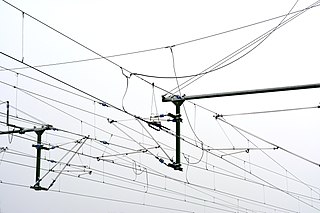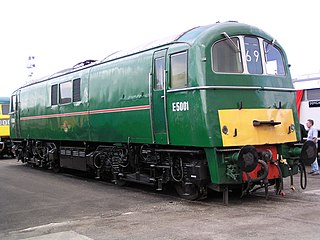This article needs additional citations for verification .(June 2021) |

Brecknell Willis is a British company headquartered in Chard, Somerset, and brand-name of electrification equipment for railways, mostly pantographs and contact shoes.
This article needs additional citations for verification .(June 2021) |

Brecknell Willis is a British company headquartered in Chard, Somerset, and brand-name of electrification equipment for railways, mostly pantographs and contact shoes.
Henry Brecknell and Sons began operating in 1854. In 1894, it moved into electrification. Since 1938 it has been in Chard, when known as Brecknell, Willis & Co. Ltd. [1]
For the London Underground, it has supplied shoe gear and conductor rail systems, as well as pantographs to the rail industry.[ citation needed ]
The Brecknell Willis Low Height pantograph is one of the four standard devices in use on British railway locomotives and multiple units and is a development of the standard Brecknell Willis High Speed pantograph. The Low Height pantograph is suitable for speeds up to 160 kilometres per hour (99 mph). It has a small aerofoil mounted on the knuckle joint between the upper and lower arms.[ citation needed ]
Although it had been used on a few rapid transit systems and on a Blackpool tram,[ citation needed ] the first use of the high reach pantograph in the UK was the main lines was back in 1974 when a small number were fitted to some Class 309s based at Ilford EMU Depot. These continued to be used until around 1980 when they were all removed.[ citation needed ]
The High speed pantograph was designed during the late 1970s and early 1980s as part of ongoing research into developing a pantograph capable of speeds over the 100 mph (160 km/h) limit of the Stone Faiveley AMBR pantograph, which was the standard type in use at the time. The first locomotive to be fitted with the pantograph was Class 86 No 86244, during February 1980. The pantograph is the mainstay within the UK railway system, where it is used on most overhead electric locomotives and EMUs. It has also been exported across the world, being used on the US high speed train Acela and the Eurostar Class 373.[ citation needed ]

An overhead line or overhead wire is an electrical cable that is used to transmit electrical energy to electric locomotives, trolleybuses or trams. It is known variously as:

A third rail, also known as a live rail, electric rail or conductor rail, is a method of providing electric power to a railway locomotive or train, through a semi-continuous rigid conductor placed alongside or between the rails of a railway track. It is used typically in a mass transit or rapid transit system, which has alignments in its own corridors, fully or almost fully segregated from the outside environment. Third rail systems are usually supplied from direct current electricity.

An electric locomotive is a locomotive powered by electricity from overhead lines, a third rail or on-board energy storage such as a battery or a supercapacitor. Locomotives with on-board fuelled prime movers, such as diesel engines or gas turbines, are classed as diesel-electric or gas turbine-electric and not as electric locomotives, because the electric generator/motor combination serves only as a power transmission system.

A railway electrification system supplies electric power to railway trains and trams without an on-board prime mover or local fuel supply. Electric railways use either electric locomotives, electric multiple units or both. Electricity is typically generated in large and relatively efficient generating stations, transmitted to the railway network and distributed to the trains. Some electric railways have their own dedicated generating stations and transmission lines, but most purchase power from an electric utility. The railway usually provides its own distribution lines, switches, and transformers.

The British Rail Class 317 is an electric multiple unit (EMU) passenger train constructed by British Rail Engineering Limited in two batches, 48 sets being produced in 1981–82 and 24 sets in 1985–87. They were the first of several classes of British Rail EMU to be based on the all-steel Mark 3 bodyshell, departing from the "PEP"-aluminium design which had spawned the earlier Class 313 to Class 315, Class 507 and Class 508. The Mark 3 bodyshell was also the basis of Class 318, Class 455, and the diesel Class 150. The Class 317 uses overhead alternating current electrification.

The British Rail Class 377 Electrostar is a British dual-voltage electric multiple unit passenger train (EMU) built by Bombardier Transportation on its Electrostar platform at Derby Litchurch Lane Works from 2001 to 2014.

A pantograph is an apparatus mounted on the roof of an electric train, tram or electric bus to collect power through contact with an overhead line. By contrast, battery electric buses and trains are charged at charging stations. The pantograph is a common type of current collector; typically, a single or double wire is used, with the return current running through the rails. The term stems from the resemblance of some styles to the mechanical pantographs used for copying handwriting and drawings.

The British Rail Class 91 is a high-speed electric locomotive, which produces power of 4,830 kW (6,480 hp); it was ordered as a component of the East Coast Main Line modernisation and electrification programme of the late 1980s. The Class 91s were given the auxiliary name of InterCity 225 to indicate their envisaged top speed of 225 km/h (140 mph); they were also referred to as Electras by British Rail during their development and throughout the electrification of the East Coast Main Line. The other end of the InterCity 225 train set is formed of a Mark 4 Driving Van Trailer, built with a similar body shell to the Class 91 locomotives but with only one driving cab. The locomotive body shells are of all-steel construction. Unusually, the motors are body mounted and drive bogie-mounted gearboxes via cardan shafts; this reduces the unsprung mass and hence track wear at high speeds. The locomotive also features an underslung transformer, therefore the body is relatively empty compared to contemporary electric locomotives. Much of the engineering specification for the locomotive was derived from the research and operational experience of the APT-P.

The Bombardier–Alstom HHP-8 is a type of twin-cab electric locomotive manufactured by a consortium of Bombardier Transportation and Alstom for Amtrak and MARC. The locomotive's electrical drive technology is directly derived from the SNCF BB 36000 manufactured by Alstom.

The British Rail Class 319 is an electric multiple unit passenger train built by British Rail Engineering Limited's Holgate Road carriage works for use on north–south cross-London services. These dual-voltage trains are capable of operating on 25 kV 50 Hz from AC overhead wires or 750 V DC from a third rail.

The British Rail Class 320 is an electric multiple unit (EMU) passenger train found on the Strathclyde rail network in Central Scotland. They are mainly used on the North Clyde Line and the Argyle Line, but they can also be seen on Glasgow Central to Lanark and Cathcart Circle and Inverclyde Line services. The Class 320 uses alternating current (AC) overhead electrification.

The British Rail Class 71 was an electric locomotive used on the Southern Region of British Railways. Unlike Southern Region electro-diesel locomotives they could not operate away from the electrified system.

The British Rail Class 325 is an electric multiple unit (EMU) train owned by and operated for the Royal Mail to carry bulk mail. The class consists of four-car sets with dual-voltage 25 kV (AC) and 750 V (DC) power. While the Class 325 cabs bear a resemblance to the Networker family of DMUs and EMUs, the Class 325 is based on the Class 319.

An electric multiple unit (EMU) is an electric train capable of operating in multiple with other EMUs that does not have a separate locomotive, typically passenger trains with accommodation in every vehicle and a driving position at each end. The term can also be used to describe a train such as the Advanced Passenger Train that was a permanent formation with a non-driving power car. As of December 2010 two-thirds of the passenger carriages in Britain are formed in EMUs.

EU06 is a class of electric locomotives in service with the Polish state railway PKP.

An electric multiple unit or EMU is a multiple-unit train consisting of self-propelled carriages using electricity as the motive power. An EMU requires no separate locomotive, as electric traction motors are incorporated within one or a number of the carriages. An EMU is usually formed of two or more semi-permanently coupled carriages, but electrically powered single-unit railcars are also generally classed as EMUs. The great majority of EMUs are passenger trains, but versions also exist for carrying mail.
Electric current collectors are used by trolleybuses, trams, electric locomotives or EMUs to carry electrical power from overhead lines, electrical third rails, or ground-level power supplies to the electrical equipment of the vehicles. Those for overhead wires are roof-mounted devices, those for rails are mounted on the bogies.

The Siemens-Duewag Supertram is a fleet of 25 trams built by Siemens-Duewag of Düsseldorf, Germany, in 1992 for use on the Sheffield Supertram light rail network in England. They were the only trams in use on the network until the entry into service of British Rail Class 399 tram-trains in 2017. As of May 2020, all 25 remain operational.

A multi-system locomotive, also known as a multi-system electric locomotive, multi-system electric multiple unit, or multi-system train, is an electric locomotive which can operate using more than one railway electrification system. Multi-system trains provide continuous journeys over routes which are electrified using more than one system.